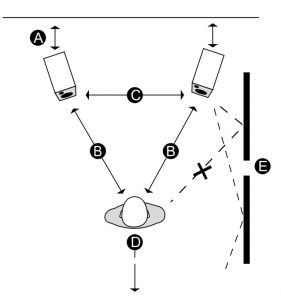The art of connecting your speakers
Poor setup and room treatment can ruin the sound of even the best audio stack. Here are some basic recommendations that have allowed us to have an awesome listening experience with our LENOIRs.
The triangle and stereo image
The triangle set-up is key to achieving something called imaging. The idea is to get an acoustic image of a singer’s voice or instrumental segment, virtually in front of you. When the position is right, you reach a sweat spot that enhances the experience. We have created a schematic to help you position the speakers in your space.

A) The speakers should be at a reasonable distance from a wall or a corner. We usually aim for 30 to 40cm to avoid blocking the rear port. Putting them too close to the wall will create a boomy and heavy sound. Move them slightly forward or backward until you get the perfect balance between treble, mid and bass.
The speakers should be elevated to ear level at the listening position and ideally sit on their own stands. Use one of our feet options, felt, rubber, or spike on the bottom of the speakers to make sure they are flat, stable, and isolated on a strong heavy support surface.
The speakers should be used vertically, not placed on their side, and not just because of the beautiful artwork on them!
B & C) The listening distance should be similar to (B) the distance apart (C). Think of a triangle. You can toe them inward if they are very far apart, however the LENOIR design has a wide horizontal dispersion so it is not necessary.
D & E) Soft surfaces such as carpets, curtains or ideally sound absorption panels will make a huge difference in the sound quality by reducing the amount of reflected sound arriving at your ear. Due to the farther distance travelled, this sound is slightly out of phase with the direct radiated sound. Distance from walls can also help reduce this effect.
For a better listening experience, make sure they are plugged into an amplifier which is turned on. With every pair of speakers, we supply 2 mounting options, the spikes and the felt feet. We have designed a support that will optimize the position and ensure they are firmly anchored.
The stack – recommended set-up
We have a stack that we really like to use for a hi-fidielity music listening experience and we think you would too! There are many ways to connect the speakers and we hope to help guide you towards your ideal set up.
Speaker wire: Use at least 16Ga finely stranded copper wire, thicker gauges have smaller numbers: eg: 14ga or 12ga are ok too. Cables have marginal effect on sound quality provided they are sized correctly to maintain low enough resistance for the current passing through them. Sometimes when the cables look really good, our brains convince us the sound is better … so we like to use the vintage cotton jacketed stuff with nice colours.
Phase: It is really important to wire the speakers in phase by matching the colours on your amp to the colours on the binding posts. Out of phase wiring causes your speakers to fight with each other instead of working as a team, resulting in reduced bass.
Other Components
We think of the audio stack as a chain, with a weakest link somewhere, and so we focus on trying to bring all elements up to a common level. Since to adequately cover this subject, we would have to write a few books, here is a tldr with some commentary on our experience
Amplifier: We recommend a min of 35Watts/ch RMS power. It is better to have more power than less, so there is no upper limit, although such a configuration requires responsible use (ie: not using the full power capacity of the amp). A lower power amplifier will audibly distort the sound at lower volume levels, providing an early indicator that you should turn it down a bit whereas a large power amp will maintain better control of the speaker drivers, reducing distortion at an equivalent volume level, but may then induce thermal failure of the voice coil assembly or crossover components. In either case, it is not safe for your ears to listen at those SPL for too long as it will damage your hearing over time.
Bluetooth: Use it only for convenience and background music. Don’t use it if you are expecting really great sound and have optimized your listening space and other components. Although there are newer codecs that can maintain high enough quality, both devices (source and sink) have to support it and almost always provide no insight as to what codec is actually being used. For digital streaming, try to stick with Airplay2, SpotifyConnect, or some other wider bandwidth network based transport/control.
Sources: We mostly stream from Spotify (to SpotifyConnect) but have tested with Apple Music over Airplay2. We have a few older turntables (Tech 1200s and 1600s) to play our Vinyl collections as well. CDs are an amazing option (from a quality perspective) and they are inexpensive at thrift shops.
Pre-Amps and DACs: Since most of our testing has been done using a Raspberry-Pi-HiFiBerry DAC combo, we haven’t played around very much in this space. When we are using analog sources, we have mostly used older integrated amps.
Maintaining the speakers
Besides the obvious Don’t poke the tweeter with a sharp object and Don’t drop them down your stairs, there are some guidelines to help keep your speakers in good shape and give you the best experience possible
- Keep your speakers free of dust. Yes, a little bit of cleaning is required! Dust them regularly with a dry cloth and do not use any cleaning fluid
- Don’t place the speakers near a heat source and ideally away from direct sunlight.
If you have made it to the bottom of this article, congratulations!


Leave a Reply